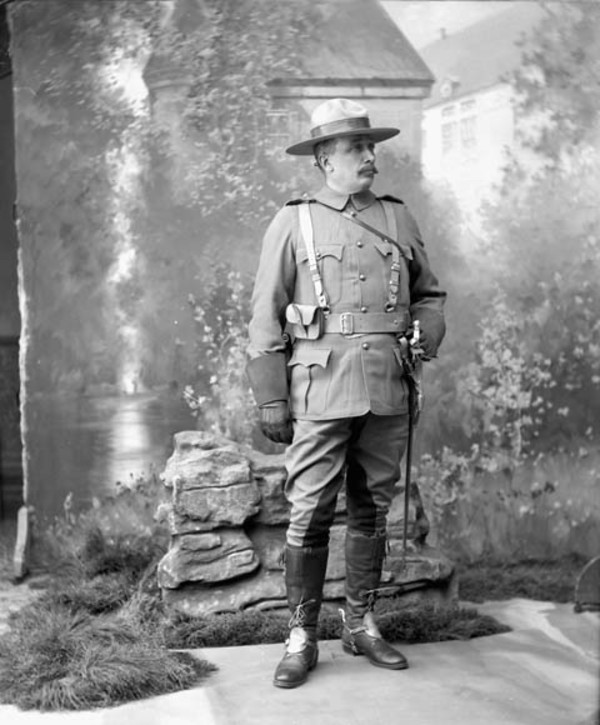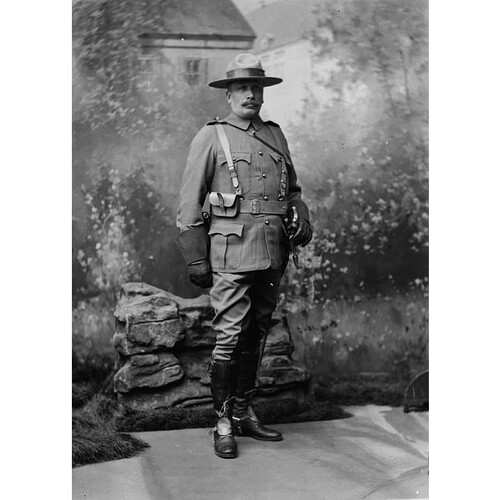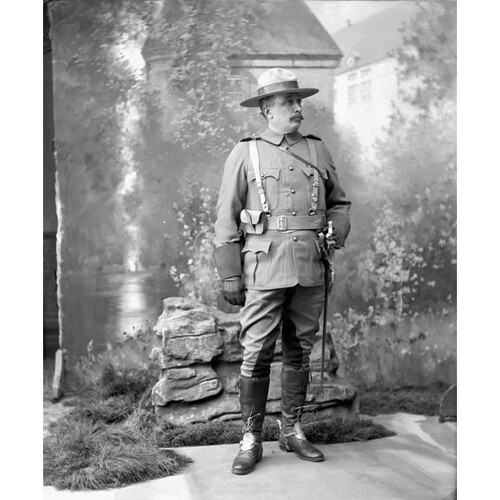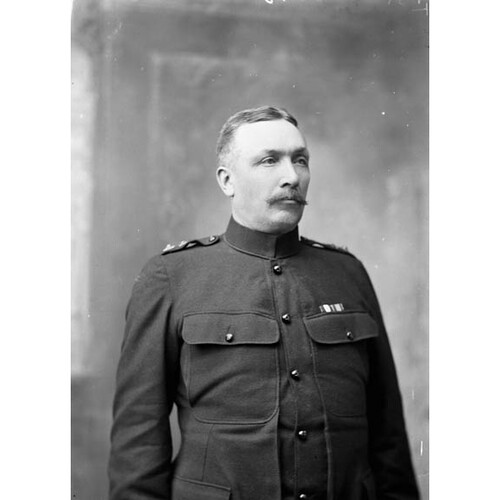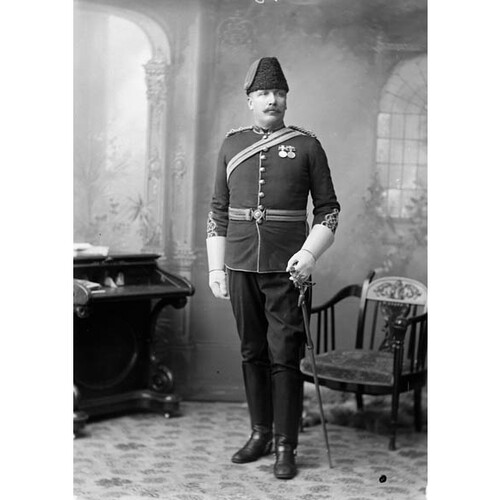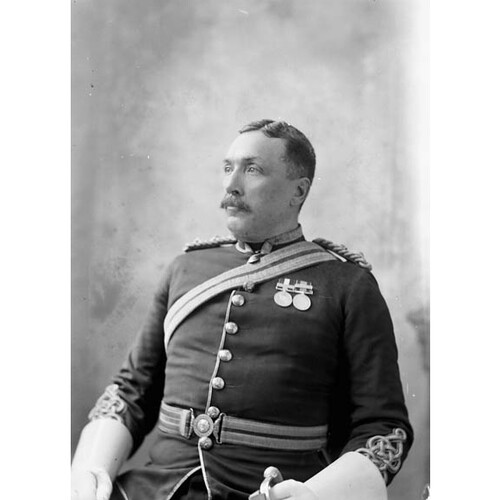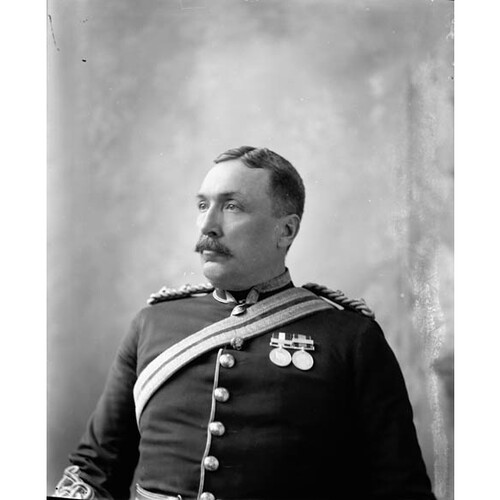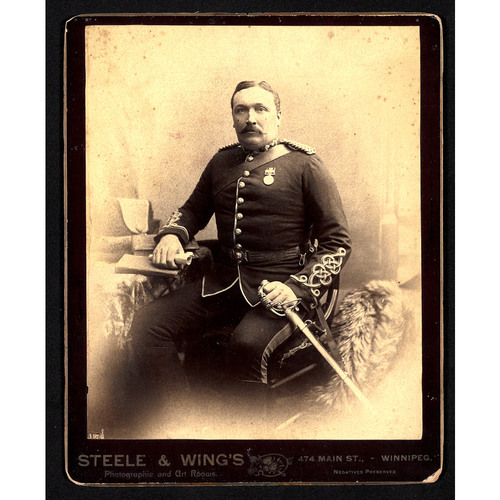As part of the funding agreement between the Dictionary of Canadian Biography and the Canadian Museum of History, we invite readers to take part in a short survey.
STEELE, Sir SAMUEL BENFIELD, NWMP officer and army officer; b. 5 Jan. 1848 in Medonte Township, Upper Canada, son of Elmes Yelverton Steele* and Anne MacIan Macdonald; m. 15 Jan. 1890 Marie Elizabeth Harwood in Vaudreuil, Que., and they had two daughters and a son; d. 30 Jan. 1919 in Putney (London), England.
Sam Steele was the quintessential Canadian man of action in the Victorian era. Physically strong and courageous, he personified the heroic qualities of the early North-West Mounted Police. He even looked the part to perfection: tall, barrel-chested, and handsome, inspiring confidence in men and admiration in women. No human, of course, could be as spotless as Steele appeared on the surface. His occasional drinking bouts were well known among his contemporaries, though he was certainly not an alcoholic. Steele was also very ambitious, and he had, in full measure, the prevailing Anglo-Saxon racist views of the period.
At the same time, Steele had important attributes that he and his contemporaries were inclined to ignore because they were less fashionable than the more obvious virtues. He was intelligent in a non-reflective way, a trait that can be seen in his autobiography, where his devotion to duty, imperial zeal, honesty, and an element of self-centredness tend to dominate. It is even more apparent in the way he approached his work. Although he cultivated the image of the bluff, open frontiersman and had no fondness for barrack-square drill, Steele was a shrewd, meticulous, and diplomatic administrator. He always spent as much time as possible preparing for a new job. Other members of the NWMP may have ridden off with adventurous notions in the Long March west of 1874. Sergeant-Major Steele left Winnipeg armed with the information gathered from six months of systematically interviewing everyone he could find who knew anything about the North-West Territories. Throughout his career Steele would approach each new challenge with the same professional thoroughness.
The son of a former naval officer and mla, Sam Steele had been educated at Purbrook, the family home in Medonte, and then at a private school in Orillia. After the death of his father in 1865, he lived for a time with his eldest half-brother, John Coucher Steele. The Fenian troubles of 1866 drew Sam into the militia, where he quickly discovered his true vocation. He served first with the 35th (Simcoe) Battalion of Infantry. After moving to Clarksburg (near Collingwood) to work as a clerk, he raised and trained a company for the 31st (Grey) Battalion of Infantry. In 1870, when a British-Canadian expedition was formed under Colonel Garnet Joseph Wolseley to maintain order at Red River (Man.), Steele was one of the many eager volunteers. On 1 May 1870 he joined the 1st (Ontario) Battalion of Rifles at Barrie. Although he had held a commission in the 35th and was offered non-commissioned rank in the 1st, Steele chose to serve as a private. “As far as experience went,” he would later write, “I was better off without chevrons and learned how to appreciate the trials of other men to an extent that I should never have been able to do had I been promoted.”
The strenuous overland journey from the Lakehead to Red River was the kind of challenge that enabled Steele to demonstrate his exceptional strength and endurance. Shortly after the expedition had settled at Upper Fort Garry (Winnipeg), he was promoted corporal. Steele enjoyed his time at Red River, but he was not tempted to stay when the battalion was disbanded in 1871.
Steele made his way instead to Kingston, Ont., where the artillery school of the Canadian Permanent Force had been established. He took a year-long course and then was assigned to Toronto to reorganize the battery there. Typically, he studied in his off hours at the British American Commercial College. After a year he was posted back to Kingston as an artillery instructor. While there in the summer of 1873 he heard that the government intended to create a mounted police force for the North-West Territories. He immediately applied to his commander, Lieutenant-Colonel George Arthur French*, for permission to join and received it, not surprisingly since French probably knew that he was to command the new force.
Steele was given the rank of staff constable (the equivalent of divisional sergeant-major) in the NWMP and he made his way westward with the first contingent in October. At Lower Fort Garry he broke horses and rigorously instructed recruits in riding. Steele was in charge of travel arrangements in June 1874 when the time came to meet the second contingent at Pembina (N.Dak.). On the Long March west that summer [see James Farquharson Macleod*], the police quickly ran into shortages of feed for their horses and cattle. The situation became so serious that a party from A Division, including Steele, had to be detached with the weakest animals and sent north along the Carlton Trail to the Hudson’s Bay Company’s Fort Edmonton (Edmonton). Getting the ailing livestock to Fort Edmonton before winter was a gruelling job but one at which Steele excelled. His commanding officer, Inspector William Dummer Jarvis, noted in his report in November that Steele had done the “manual labour of at least two men” on the journey.
With the rest of A Division, Steele spent the winter at Fort Edmonton, making occasional journeys outward to gather information and to clear the area of whisky traders. When spring came, the police moved down river and built their own post, Fort Saskatchewan (Alta). In July 1875 the steamer Northcote brought orders promoting Steele to chief constable, effective in August, and transferring him to headquarters at Swan River Barracks (Livingstone, Sask.). In the summer of 1876 he was put in charge of moving the headquarters to Fort Macleod (Alta) and, along the way, making arrangements for the large police contingent at the Treaty No.6 negotiations with the Cree at forts Carlton and Pitt (Sask.).
At Fort Macleod Steele continued his administrative duties, trained horses, and acted as clerk for the busy criminal sessions conducted by the officers in their capacity as justices of the peace. In October 1877 he was one of the party of Commissioner J. F. Macleod that went to Fort Walsh (Sask.) to conduct negotiations between Sitting Bull [Ta-tanka I-yotank*] and General Alfred Howe Terry of the United States army. After the talks failed to persuade Sitting Bull to return to American territory, a failure Steele regarded as inevitable, he returned to Fort Macleod. The following year the headquarters was moved to Fort Walsh because of the concentration of indigenous people in the Cypress Hills. Promoted sub-inspector in 1878, Steele remained there until 1880, when he was made an inspector and assigned to his first independent command, Fort Qu’Appelle (Sask.).
The duties of the NWMP, hitherto focused on the indigenous population, began to change rapidly with the coming of the transcontinental railway. The main line of the Canadian Pacific Railway bisected Steele’s district, and he found himself occupied with disputes generated by settlement and construction. As the railway advanced west in the summer of 1882, he was put in charge of policing the line. Moving with the construction camps, he laid out the NWMP post at Regina, to which the force’s main headquarters was transferred in December. Most of his work was in his capacity as a magistrate. Settling labour disputes and keeping gamblers and whisky sellers within limits was just the kind of job that Steele’s forceful personality, sense of humour, and boundless energy were suited to. When construction reached Fort Calgary (Calgary) in the fall of 1883, he stayed there as commanding officer.
In April 1884 Steele was assigned to accompany the CPR into British Columbia. He had no doubt that the completion of the railway was a work of national importance and that his job was to further that work by any means at his disposal. He increased his power by having Ottawa double the area of federal jurisdiction over the construction route, from 20 miles on each side of the track to 40. In the spring of 1885, at Beaver (Beavermouth), B.C., in the Selkirk Mountains, a serious labour dispute developed over non-payment of wages by subcontractors. Gravely ill with fever, Steele rose from his sickbed to read the Riot Act to an angry mob of strikers and, though he was armed, he dispersed them through sheer force of personality. The action was pure Sam Steele, though it should be noted that major discrepancies exist between the official reports he wrote at the time of the strike and his published reminiscences many years later.
The strike had escalated to the point of violence in part because Steele’s detachment had been stripped of men to respond to the crisis on the prairies created by Louis Riel*’s proclamation of a provisional government in March. As soon as the strike was over, on 7 April, Steele and the rest of his men also headed eastward. On arrival in Calgary, Steele was appointed to command the mounted troops and scouts of Major-General Thomas Bland Strange*’s Alberta Field Force. They consisted of some 110 ranchers and cowboys along with 25 policemen. Steele’s Scouts led the way north to Edmonton and then down the North Saskatchewan River in pursuit of Cree chief Big Bear [Mistahimaskwa*], whose band had killed a number of people at Frog Lake (Alta).
Steele was one of the few senior NWMP officers to come out of the North-West rebellion with their reputations enhanced. Although hampered by the slow pace of Strange’s footsore infantry, Steele had led his scouts with imagination and aggressiveness. His small force was the only unit able to keep up with Big Bear before his surrender in July 1885. Strange’s recommendation that Steele be awarded a cmg was ignored, but Steele was somewhat consoled by news of his promotion in August to superintendent, just as his Scouts were being disbanded. In the fall he returned to law enforcement along the CPR in British Columbia. Appropriately, he was present at the driving of the last spike, at Craigellachie in November.
After a quick trip to the coast on the first through train, Steele was posted to Battleford (Sask.) in command of D Division. He spent most of his time training the recruits who had come in with the doubling in size of the NWMP in 1885. In September 1886 his division was sent to Fort Macleod and early in 1887 it moved to Lethbridge, the new headquarters for southern Alberta.
A few months later a new crisis took Steele back to British Columbia. A dispute between the province and the Kutenai (Ktunaxa) over reserves and the arrest of one of their people threatened violence. The province requested aid from Ottawa, and Steele and 75 policemen were sent in. After arriving in August 1887, they built a post (Fort Steele) and set about investigating the dispute. Steele released the accused and seems to have persuaded Kutenai chief Isadore* of the futility of armed resistance. By August 1888 the services of the NWMP were no longer needed and they returned to Lethbridge.
In December Steele was given command at Fort Macleod, which then had more policemen than any post except Regina. It was the beginning of the least eventful decade of his career. The NWMP was at its maximum strength, the indigenous population was quiet, and the massive influx of settlers to the prairies was yet to come. In 1890 Steele was able to take several months’ leave to travel to Quebec to get married. His fiancée, Marie Harwood, had come to Fort Macleod in 1889 to visit her aunt, the wife of Steele’s friend Superintendent Alexander R. Macdonell. Marie was wealthy and well connected: her father, Robert William Harwood, had been an mp, and her paternal grandmother, the wife of Robert Unwin Harwood*, was a member of the socially and politically prominent Chartier de Lotbinière family of Vaudreuil. Marie was also athletic and outgoing; she and Sam appear to have fallen in love immediately and decided to marry despite their religious differences.
Like most of the officers in the NWMP, Steele found Lawrence William Herchmer, its commissioner since 1886, difficult to get along with. Many in the force, not least Steele himself, thought he would be a better leader. Although he was not publicly critical of Herchmer, Steele became the focus for those who were unhappy with his leadership. In 1892, when the assistant commissioner’s job became vacant, Steele was the most experienced superintendent, though others had achieved that rank before him, and had the most distinguished record in the force. He lobbied for the job and did not hesitate to use the political connections of his wife’s family. But the position went to Superintendent John Henry McIllree, a less assertive officer who was not expected to clash with the abrasive Herchmer.
Steele’s period of routine administration in southern Alberta ended abruptly after gold was discovered in the Yukon. When it became apparent in 1897 that a major rush would develop, the police force there was strengthened under the initial command of James Morrow Walsh*. In January 1898 Steele was ordered north to establish (with Superintendent Aylesworth Bowen Perry) and then take command of the customs posts at the height of the White and Chilkoot passes and at Bennett Lake, the headwater of the Yukon River and the main staging area of the rush. When Steele arrived the following month, there were only a few policemen in the Yukon; by the time he left a year and a half later, almost a third of the NWMP would be under his command. The minister in charge of the Yukon in the federal Liberal government, Clifford Sifton*, had arranged for the police there to report directly to Ottawa, bypassing Regina, so that the contingent was virtually a separate force.
Nothing could have suited Steele better. Not only could he run the police as he saw fit, but the isolation of the Yukon allowed him to make up laws and regulations as necessary. The most famous example of this unilateral authority occurred at Bennett during the spring breakup of 1898, when Steele dictated that all prospective miners register their boats and adhere to strict rules for navigation when heading down river. Later in the year he refused to allow anyone into the territory without a minimum quantity of food and money. These actions were blatantly illegal, as Steele cheerfully admitted, but they so obviously saved lives that both the miners and Ottawa accepted them.
In July 1898 Steele assumed command of all the NWMP in the Yukon and became a member of the newly formed territorial Council; from that point on he could exercise his legislative talents legally. Administrative duties and preparations prevented his moving from Bennett to Dawson, the chaotic metropolis of the Klondike, until September. There Steele concentrated on keeping order. Gambling and saloons were tolerated but strictly controlled; observers reported that Sundays were as quiet as those in Toronto. Steele put minor offenders to work cutting firewood for police headquarters while dubious characters were shipped out on the first available boat. The miners, mostly Americans, might have been expected to chafe under this stern regime, but that seems not to have been the case. When Steele was transferred out of Dawson in September 1899, reputedly for resisting the partisan system of patronage sanctioned by Sifton, virtually the entire population turned out to cheer him, and the miners presented him with a bag of gold-dust.
Before Steele could be assigned to new duties, the South African War broke out in October. Steele immediately volunteered, went on leave from the force, and was swept up in the confusion that marked Canada’s decision to participate in the conflict. In short order he was offered the position of second in command of the Royal Canadian Dragoons, which he rejected because he felt that not enough mounted policemen were being allowed to volunteer. He then accepted an offer to command a regiment to be formed in western Canada (the 1st Canadian Mounted Rifles), but he agreed to step down to second in command when Commissioner Herchmer decided he wanted the position. He had just started recruiting men and buying horses when, in January 1900, he was offered command of a British army unit to be recruited in Canada and sponsored by Lord Strathcona [Smith].
Although the NWMP had been picked over by the earlier contingents, Steele managed to get enough officers and NCOs he trusted to provide the backbone for Lord Strathcona’s Horse. From the outset he insisted on creating and promoting regional formations within this corps of western horsemen. As soon as they were assembled, Steele began a rigorous training program. On the journey across the Atlantic, he organized every day, thus preventing the deterioration of morale that plagued other Canadian units. Once in South Africa, Steele used all his skills, together with the substantial influence of Strathcona’s name, to ensure that his unit was not dispersed or given routine assignments.
By the time it was ready to take the field in May 1900, the conventional phase of the conflict was over and guerrilla warfare had begun. After taking part in an abortive scheme to blow up a railway bridge on the border of Portuguese East Africa (Mozambique), the regiment spent the next seven months scouting for the columns pursuing the elusive Boer commandos. The pursuit was usually too cautious and ponderous to suit Steele, but his unit performed well – one of its sergeants, Arthur Herbert Lindsay Richardson, won Canada’s first Victoria Cross of the war – and it drew praise from the British high command. By the time the Strathconas were ready to return to Canada in January 1901, Steele’s leadership had attracted the attention of Major-General Robert Stephenson Smyth Baden-Powell, who offered him a divisional command in the South African Constabulary he was organizing. Awarded an mvo in England, on the Strathconas’ trip home, Steele was made a cb during his brief sojourn in Canada. In June he was back in South Africa with the SAC.
Two allegations about Steele’s conduct in South Africa that would cast him in unfavourable light have been addressed in some histories of the period. Sandra Gwyn’s study of Ottawa society passes on the charges of Lieutenant Agar Stewart Allan Masterton Adamson* of the Strathconas that Steele was a boorish lout who spent his time getting drunk and did not take care of his soldiers. Steele did drink to excess on occasion and his manners perhaps fell short of the social standards Adamson had become accustomed to in Ottawa and as a student at Cambridge, but the accusation that he ignored the welfare of his troops is so out of line with the rest of his career that it can safely be dismissed.
The other accusation was a good deal more serious. In August 1900 a party of the Strathconas witnessed an incident, typical of this period of the war, in which a detachment of the South African Light Horse approached a Boer farm displaying a flag of truce, were fired upon, and had some men killed or wounded. The Strathconas allegedly responded by capturing those responsible, helping the Light Horse hold a “court martial,” and hanging six of the Boers on the spot. Reports of the incident in the press were denied by Steele and his superiors, but Carman Miller’s careful study of the episode, in his work on the Canadians in South Africa, leaves little doubt that the hangings occurred and were covered up by Steele and others.
Steele’s five years with the SAC were frustrating for him, although in some respects his leadership was more influential than it had been in Canada. He had expected to choose his own officers and to keep the 1,200 Canadians recruited for the force together under his command. Instead, the governor general of Canada, Lord Minto [Elliot], usurped the appointment of officers and Baden-Powell insisted upon distributing the Canadians among the four divisions of the SAC.
The last year of the war was spent pacifying the countryside by pursuing the remaining Boer commandos. Even before hostilities formally ended in May 1902, Steele had begun the process of converting his unit to civilian duty. He knew from his Canadian experience that no police force could function effectively without public cooperation. To Steele this meant winning the confidence of the Boer farmers by supplying practical services. In addition to providing security, the SAC acted as game-wardens, veterinarians, census takers, and licence issuers. As soon as the war ended, he stepped up the transition, encouraging his men to learn Afrikaans, pushing the authorities to allow the Boers to have their rifles back, and persuading the government to appoint senior officers as magistrates. That the policy of conciliating the Afrikaner population meant abandoning the black majority to their mercies bothered Steele not at all. He considered the “Kaffir” a natural subject race.
As a transitional institution, the SAC was a success. Its life was inherently limited, however, a fact that Steele recognized by recruiting Afrikaner constables to replace those from Britain and the dominions who left. By 1906 the force was being cut severely and Steele, who had officially retired from the NWMP in 1903, was making plans to leave. After eight months in England as adjutant to Baden-Powell, then inspector general of cavalry, Steele returned with his family to Canada, where in 1907 he was appointed commanding officer of Military District No.13 (Alberta and the District of Mackenzie). In 1910 he was transferred to command the more important Military District No.10, based in Winnipeg. There, among other things, he worked on reconstituting Lord Strathcona’s Horse as a Canadian cavalry unit and on preparing his memoirs.
The outbreak of World War I in August 1914 postponed the release of Steele’s memoirs, then ready for publication, and removed any thoughts of civilian life from his mind. Although he was 66 (at the time he claimed to be 62), Steele hoped to command the 1st Canadian Division, but the minister of militia and defence, Samuel Hughes*, rejected him on the grounds of age. Within a few months it became apparent that the war would last for some time and would require more military effort. In December 1914 Hughes promoted Steele to major-general and put him in charge of training in western Canada. When formation of the 2nd Canadian Division was announced early in 1915, Steele was offered command and he accepted.
At the British War Office Lord Kitchener vetoed the appointment because he believed Steele was too old for an active combat command. Infuriated, and pressured by western Tories, the obstreperous Hughes now insisted that Steele be given the post, even though he still thought him to be overage and inexperienced with large military formations. A compromise was reached under which Steele would head the 2nd until it was sent to France. After assuming command on 25 May 1915, he handled its organization in Canada and training in England until he was replaced by Major-General Richard Ernest William Turner* in August.
One of the legacies of Steele’s service in South Africa was that his commission was in the British army. Kitchener was thus able to offer him an administrative post as commanding officer of the Southeastern District of England, which included the principal Canadian training camp, at Shorncliffe. Steele, who took up this command on 5 August, might have served out the war in useful semi-obscurity if it had not been for Hughes’s genius for administrative muddle. Hughes had decided that, in addition to his British appointment, Steele should have command of all Canadian troops in England, effective 3 August. This step inevitably brought about conflict with Brigadier-General John Wallace Carson, special representative of the minister of militia, and Brigadier-General James Charles MacDougall, general officer commanding Canadian troops in the United Kingdom, both of whom thought they were in overall command.
The situation remained unresolved until Hughes fell from power in November 1916. The newly appointed minister of overseas forces, Sir George Halsey Perley*, moved quickly to sort out the mess. After Steele refused to return to western Canada as a recruiter, he was relieved of his Canadian command on 1 Dec. 1916. Created a kcmg on 1 Jan. 1918, he retained his British command until 1 March and was retired on 15 July.
During his career Steele had had considerable impact on western and northern Canada in terms of law enforcement, but his effect on the NWMP itself was not as great. He drew much favourable publicity to the force. Because he was fair, hard-working, and organized, he was always very popular with those under his command. He was almost certainly correct in his self-assessment that training recruits was one of his greatest strengths. Steele was just as clearly not in the least innovative in administrative or organizational matters, unlike the irascible and unpopular Herchmer. In the Yukon he repeated the experience of the NWMP on the prairies with no significant change. Steele’s innovations came in South Africa, where he tried to adapt as much of the NWMP system to local conditions as possible.
Sam Steele died just after his 71st birthday in England, one of the many victims of the influenza epidemic of 1918. He was buried in St John’s cemetery in Winnipeg on 3 July 1919. A group of his friends had had a death mask made with the intention of commissioning a statue. That it never materialized says much about Steele’s life and career. He was like one of those organisms so perfectly adapted to their environment that a change in external conditions results in extinction. The Great War had so changed Canada and the world that in 1919 Steele’s exploits no longer seemed significant. This apparent irrelevance should not obscure the fact that he was an important builder of western Canada.
Samuel Benfield Steele’s autobiography was published as Forty years in Canada: reminiscences of the great north-west with some account of his service in South Africa, ed. M. G. Niblett (Toronto and London, 1915; repr. 1972).
ANQ-M, CE1-50, 15 janv. 1890. DCB, Biog. data file, E. Y. Steele and S. B. Steele. GA, M305; M776; M1171; M4317. NA, RG 18; RG 150, Acc. 1992–93/166. Royal Canadian Mounted Police Headquarters (Ottawa), Hist. sect., Service file O.40. Manitoba Free Press, 4 July 1919. Can., Parl., Sessional papers, 1909, no.35: 12; 1911, no.35. Canadian men and women of the time (Morgan; 1912). Sandra Gwyn, The private capital: ambition and love in the age of Macdonald and Laurier (Toronto, 1984). R. C. Macleod, The NWMP and law enforcement, 1873–1905 (Toronto, 1976). A Medonte pioneer and his famous son (Orillia, Ont., 1954; copy in DCB, Steele file). Carman Miller, Painting the map red: Canada and the South African War, 1899–1902 (Montreal and Kingston, Ont., 1993). W. R. Morrison, Showing the flag: the mounted police and Canadian sovereignty in the north, 1894–1925 (Vancouver, 1985). Standard dict. of Canadian biog. (Roberts and Tunnell), vol.1. Robert Stewart, Sam Steele, lion of the frontier (Toronto and New York, 1979).
Revisions based on:
Parish registers in the archives of St James’ Anglican Church in Orillia, Ont., include those of St George’s Church in Fairvalley (Medonte Township), in which Sir Samuel Benfield Steele’s birth entry is recorded as 5 Jan. 1848. There has been much confusion about Steele’s birth year. His autobiography gives 1849, the year shown on his gravestone. Steele’s son, Harwood, insisted that 1851 was correct and that the autobiography had been revised incorrectly. Some secondary sources use 1851, whereas 1852 is recorded in Steele’s World War I personnel file. The DCB/DBC is grateful to Murray Cayley, author of “Happy birthday(s), Sam Steele,” Beaver (Winnipeg), 88 (2008), no.4: 56–57, for informing us about his discovery of Steele’s birth and baptismal registrations in the records held at St James’ Anglican Church.
Cite This Article
Roderick Charles Macleod, “STEELE, Sir SAMUEL BENFIELD,” in Dictionary of Canadian Biography, vol. 14, University of Toronto/Université Laval, 2003–, accessed March 29, 2025, https://www.biographi.ca/en/bio/steele_samuel_benfield_14E.html.
The citation above shows the format for footnotes and endnotes according to the Chicago manual of style (16th edition). Information to be used in other citation formats:
| Permalink: | https://www.biographi.ca/en/bio/steele_samuel_benfield_14E.html |
| Author of Article: | Roderick Charles Macleod |
| Title of Article: | STEELE, Sir SAMUEL BENFIELD |
| Publication Name: | Dictionary of Canadian Biography, vol. 14 |
| Publisher: | University of Toronto/Université Laval |
| Year of publication: | 1998 |
| Year of revision: | 2021 |
| Access Date: | March 29, 2025 |


